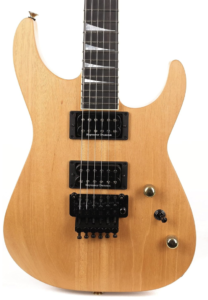Remembering the guitar string order can be made easier with a few mnemonic devices and practice techniques. Here are some methods to help you memorize the standard tuning of a six-string guitar (from thickest to thinnest string):
String Order For Guitar
 The standard guitar string order tuning for a six-string guitar, from thickest to thinnest string, is as follows:
The standard guitar string order tuning for a six-string guitar, from thickest to thinnest string, is as follows:
- 6th String (Low E) – Thickest string, closest to your face when holding the guitar. It produces the lowest pitch.
- 5th String (A) – The next string, slightly thinner than the low E string.
- 4th String (D) – The middle string in terms of thickness and pitch.
- 3rd String (G) – Thinner than the previous strings, producing a higher pitch.
- 2nd String (B) – Another thinner string.
- 1st String (High E) – The thinnest string, farthest from your face when holding the guitar. It produces the highest pitch.
Use Mnemonics
Create a phrase or sentence where the first letter of each word corresponds to the string names. One common mnemonic is: “Eddie Ate Dynamite, Good Bye Eddie” which stands for EADGBE (the standard tuning). You can create your own memorable sentence as well.
Mnemonics are memory aids that help you remember information by creating associations with easily recallable cues. Here’s how you can use a mnemonic to remember the order of guitar strings:
- Create a Mnemonic Phrase: Start by creating a memorable phrase where the first letter of each word corresponds to the string names. Let’s use the phrase “Every Adult Dog Growls, Barks, Eats.”
- Associate String Names: Break down the phrase and associate each word with the corresponding string name:
- “Every” for E (6th string, low E)
- “Adult” for A (5th string)
- “Dog” for D (4th string)
- “Growls” for G (3rd string)
- “Barks” for B (2nd string)
- “Eats” for E (1st string, high E)
- Visualize the Image: Visualize a playful image in your mind that involves an adult dog growling, barking, and eating. Connect this image to the guitar strings as if the dog is interacting with them.
- Practice and Repeat: Mentally go through the mnemonic and visualize the associated image. Say the mnemonic out loud several times, emphasizing the string names. As you do this, imagine the actions of the dog along with the corresponding strings.
- Apply to Real Guitar: Now, pick up your guitar and identify each string while saying the mnemonic. Pluck each string in sequence, repeating the mnemonic phrase as you go along.
- Review Regularly: Practice this mnemonic daily or frequently until you no longer need to rely on it. Over time, you’ll internalize the order of the strings, and the mnemonic will become a helpful memory trigger.
Also Read:
Notes on Guitar String: Easily Finding All Guitar Notes
Top Tips to Play Guitar Chords
PRS SE Custom 24 Guitar Review
Different Mnemonics to Remember the String Notes
 Here are 10 different mnemonic phrases you can use to remember the guitar string order:
Here are 10 different mnemonic phrases you can use to remember the guitar string order:
- Eddie Ate Dynamite, Good Bye Eddie: Corresponds to EADGBE, the standard tuning of guitar strings.
- Elephants And Donkeys Grow Big Ears: Relates to EADGBE as well, using a different sentence structure.
- Eat All Day, Get Big Easy: An alternate way to remember EADGBE.
- Every Apple Does Grow Beautifully Everyday: Another phrase to represent EADGBE in a creative manner.
- Good Boys Don’t Fear Anything: Represents the strings in reverse order: EBGDAE.
- George Bush Drives Fast And Eats Birds: An acronym for the reversed string order GBDFAE.
- Big Elephants Are Deaf, Good Bye Elephants: Relates to the reversed string order BEADGC.
- Bunnies Eat All Day, Gaining Calories: A phrase for the reversed string order BEADGC.
- Even A Dog Gets Barks Eventually: Represents the strings in standard order: EADGBE.
- Dogs And Cats Eat Grass, Bark Evenings: Another mnemonic for the standard tuning EADGBE.
Feel free to choose the mnemonic that resonates most with you or even combine elements from different phrases to create your own unique memory aid. The goal is to find something that helps you remember the order of the guitar strings effectively. Notice that you should choose only ONE such mnemonic and start using it as soon as possible.
Other Strategies to Remember String Notes
 Here are some additional strategies you can use:
Here are some additional strategies you can use:
- Physical Touch and Feel: Run your fingers across the strings while saying their names. The tactile sensation combined with verbal repetition can enhance your memory.
- Practice Playing Scales: Play simple scales like the chromatic scale or the major scale while saying the string names out loud. This practical approach helps associate the strings with the sound and finger positions.
- Create a Song or Melody: Compose a simple tune that follows the string order. Sing or hum this tune to yourself to remember the string names in sequence.
- Write It Down: Write down the string names repeatedly, either on paper or on a digital device. The act of writing engages different parts of your brain and reinforces the memory.
- Associate with Numbers: Assign a number to each string and create a numerical sequence to remember. For example, you could associate 6 with “sixth string,” 5 with “fifth string,” and so on.
- Practice Regularly: Consistent practice is key. The more you engage with the strings, the more likely you are to remember their order naturally over time.
- Incorporate Visual Aids: Use diagrams, charts, or flashcards that display the string names and their order. Having a visual reference can help reinforce your memory.
- Play Simple Chords: Learn basic chords and focus on finger placement. As you practice chords, you’ll naturally become familiar with the string order.
- Teach Someone Else: Explain the string order to a friend or family member who’s interested in learning the guitar. Teaching someone else reinforces your own understanding and memory.
Using Chords to Remember Notes
 Using chords is a practical and musical way to remember the order of guitar strings. Here’s how you can use chords to help you remember the string names:
Using chords is a practical and musical way to remember the order of guitar strings. Here’s how you can use chords to help you remember the string names:
- Learn Basic Chords: Start by learning a few basic open chords, such as E major, A major, D major, G major, C major, and F major. These chords are commonly used and will provide a good foundation for string memorization.
- Visualize String Names: As you play each chord, say the string names out loud as you pluck them. For example, when playing an E major chord, say “6th string, 5th string, 4th string, 3rd string, 2nd string, 1st string” as you pluck each string.
- Associate with Fingers: Pay attention to which fingers you use to fret the chords. Associate each finger with the string it’s placed on. For example, when playing an E major chord, your index finger is on the 3rd string, middle finger on the 5th string, and ring finger on the 4th string. This association can reinforce your memory.
- Play Progressions: Practice chord progressions that involve transitioning between the chords you’ve learned. As you switch between chords, continue to verbalize the string names. This helps you become comfortable with the order of strings in a musical context.
- Create a Chord Sequence: Develop a chord sequence that follows the order of the strings. For example, you can create a sequence that goes from E major to A major to D major, and so on. Playing this sequence regularly will help you internalize the string order.
- Play Along with Songs: Look for songs that use the chords you’ve learned. As you play along, focus on the string names and the order in which they are played within the chords.
- Experiment with Strumming Patterns: Experiment with different strumming patterns while naming the strings you’re strumming. This adds a rhythmic element to your practice and reinforces the string order.
- Challenge Yourself with Barre Chords: As you progress, learn barre chords that require you to fret multiple strings with a single finger. This will further strengthen your association between fingers and string names.
